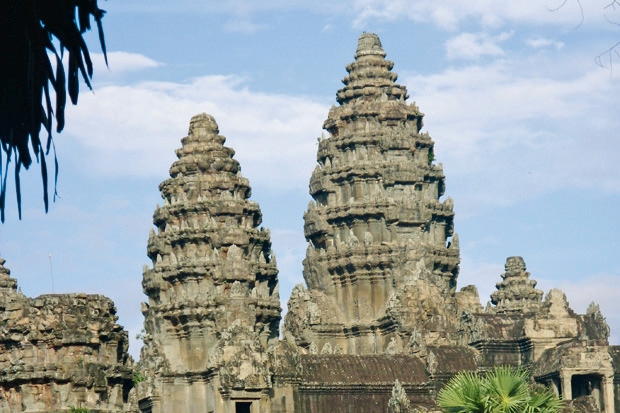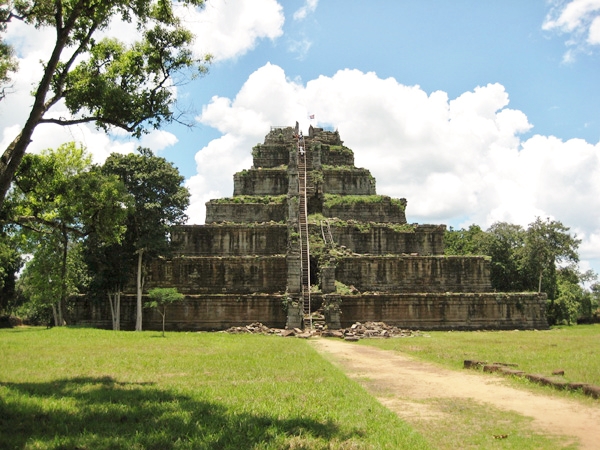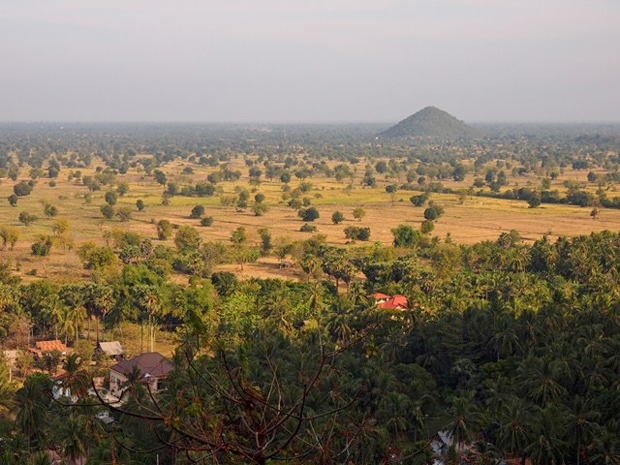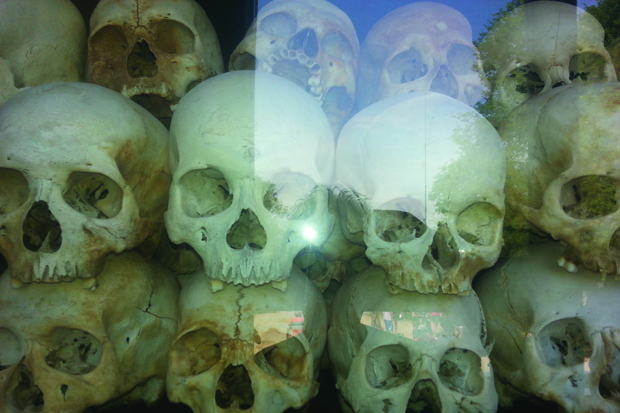While the serene southeast Asian destination is home to the largest religious site in the world, its killing fields are testament to a sinister past.
By Richard Hoath Photos by Richard Hoath and courtesy of Wikimedia
Sometimes life is just good. I am on a boat on the Kampong Bay River in Kampot in southeastern Cambodia. Along the banks are mangroves and palms and houses on stilts high enough to keep the wet season’s rain out and draped with colorful laundry. Pacific Swallows and Asian Palm Swifts cleave the air. The Coppersmith Barbet calls and the cicadas chur. Serenity. Karma. This is how Southeast Asia is meant to be. This is how Cambodia is.
There’s barely a current, barely a breeze and yet the backdrop is the forest clad-mountains of Bokor swathed in fierce swirls of cloud and doubtless drenched in tropical rain. But if rainforest conjures up images of festering heat and humidity, then it ain’t necessarily so. Bokor that morning was cold, cloudy and wet and for a frustrated naturalist, largely creatureless. But there was serendipity. On those hills after a largely barren trek through the rainforest I heard a deep guttural bray. On a hunch I swept the binoculars skywards and there, in a tree of huge proportions was a bird of huge proportions — the Great Hornbill, all stonking 120cm of it with a bill like a pickaxe and a horn like a rhino. After it brayed it flew with the loud, audible whoosh of the field guides. Luck? Serendipity.
The usual entry to Cambodia is the capital Phnom Penh and arrival in Phnom Penh is not serenity and karma — more velocity and chaos. Most cities bustle, but Phenom Penh bustles differently. For now it is a low-rise city, though high-rise construction is mushrooming, and the streets are packed to bursting point with scooters, mopeds, tuktuks and motos — the ubiquitous motorbike taxi. The motorcycle rules. The traffic is chaotic but the streets are easy to negotiate once you have mastered the knack of hanging on to your moto seat.
[caption id="attachment_345259" align="alignnone" width="490"] A zahma, or traffic jam, Phnom Penh-style. (photo by Richard Hoath)[/caption]
A zahma, or traffic jam, Phnom Penh-style. (photo by Richard Hoath)[/caption]
I doubt whether many people come to Cambodia for Phnom Penh. The royal palace is regal and opulent in golds and scarlets and silvers but the Mekong, one of the world’s mightiest rivers, is leaden and lackluster. One does not envy the last few Irrawaddy dolphins that ply its waters at Kratie far to the east and north. The banks though are anything but leaden, the riverside thronging with picnickers and promenaders.
A seven-hour bus ride north of Phnom Penh is Siem Reap. The town of Siem Reap is unremarkable in itself and would barely be on the traveller’s map were it not for its location. Siem Reap is the base for trips to the Hindu temple complexes of Angkor and to Angkor Wat itself, the single largest religious site in the world and on its own a temple that simply defies description. The three main towers of the temple appear not only on the Cambodian currency, the riel, but on the national flag itself. In terms of numbers, this 12th century heaven on Earth is 1.5 by 1.3 kilometers and surrounded by a moat that is almost 200 meters wide. The outer walls are 1,025-by-800 meters and, according to the inscriptions on these massive walls, its construction involved 300,000 workers and 6,000 elephants. The inner temple rises in tiers and the iconic lotus-bud towers peak at 55 meters above the plains. On its own Angkor Wat would be an architectural phenomenon to rival Giza’s pyramids. But it is not on its own. The site of Angkor covers an estimated 1,000 square kilometers.
Perhaps as amazing as the monuments themselves is just how organized the site is. A pass can be bought for one, two or seven days; a process that takes just minutes. Once purchased that is that. There are no further entrance charges, the pass is checked at each temple and there is no hassling and hawking for guides. There is none of the chaos, intimidation and even nastiness of the Pyramids. There are markets and stalls and outdoor cafes but again very little bother and the bother that exists is friendly and low key. It was a revelation!
[caption id="attachment_345261" align="alignnone" width="620"] Angkor Wat (Photo by Richard Hoath)[/caption]
Angkor Wat (Photo by Richard Hoath)[/caption]
To understand Angkor you need to travel 130 km northeast of Siem Peap to Koh Ker. The temples here have almost surrendered to the jungle and have an other-worldly air about them perhaps best compared to the Mayan temples of Tikal in distant Guatemala. Constructed in the 10th century, they might be described, as they were by my guide, as a practice, an experiment for the glories of Angkor. Today, the walls and palaces and temples are fighting a losing battle against the forest, wrested apart and entangled by giant banyans and strangler figs. That too is the case in Angkor itself where the temple of Ta Prohm leapt to fame in the Tomb Raider movies. Ta Prohm does not need Angelina Jolie to make it a truly magical place.
[caption id="attachment_345262" align="alignnone" width="600"] Koh Ker (photo via Wikimedia)[/caption]
Koh Ker (photo via Wikimedia)[/caption]
You are not alone at Angkor and never less alone than at sunset when everyone gathers for the sunset selfie (selfie takers are the site’s biggest curse) and nowhere more than at the multi-tiered temple of Pre Rup. I visited in late afternoon and already the crowds were gathering with the sun still high in the sky, their eyes trained prematurely to the west. It had been raining and behind them was a rainbow arching across the sky and the dusky silhouettes of the lotus towers. It was beautiful, and most were oblivious. A sunset happens every evening. A rainbow is special.
Flash forward. I am in Battambang in western Cambodia and I have struck gold. Battambang is an old French outpost and the colonial buildings in various stages of decay or restoration are still a feature along the banks of the Sangker River. I do not really do luxury but I am staying at La Villa, a villa on the opposite bank, and it is a little piece of heaven. Built in the early 20th century, it has been beautifully restored. I have Room 1 but make that suite 1. There is a huge four-poster bed decked out in crisp linen and a mosquito net. There is a bathroom so large I can get lost and best of all a salon with a period bureau decked out with period picture frames and lamps and where my notebooks and sketch pads, pencils and crayons look so appropriate. A ceiling fan whirs and outside is a terrace filled with the babblings of bulbuls and the chortlings of mynahs. It’s also where breakfast is served with Cambodian tea, jackfruit and dragon fruit.
[caption id="attachment_345276" align="alignnone" width="620"] A large statue in Battambang of Ta Dambong, a farmer who found a magic stick and used it to usurp the king. (Photo by Richard Hoath)[/caption]
A large statue in Battambang of Ta Dambong, a farmer who found a magic stick and used it to usurp the king. (Photo by Richard Hoath)[/caption]
From Battambang I arrange a remork, the motorcycle rickshaw that is Cambodia’s workhorse out to Phnom Sampeau. All around is flat rice padi and farmstead but out of the padi emerges Phnom Sampeau, a cliff skirted massif capped with forest and a series of Buddhist temples that break the canopy and afford magnificent panoramas over the low-lying plains. Today, it is a place of celebration but it has a darker past. Phnom Sampeau is also the site of the Killing Caves, a deep cavern now shrine where victims of Pol Pot’s genocidal regime were taken and bludgeoned to death.
[caption id="attachment_345277" align="alignnone" width="620"] Surrounding countryside at Phnom Sampeau (Photo via Wikimedia)[/caption]
Surrounding countryside at Phnom Sampeau (Photo via Wikimedia)[/caption]
For the gourmet there is Kep on the south east coast of Cambodia. I am not a gourmet and for me Kep was an incredible National Park with Ruby-cheeked Sunbirds, White-headed Laughing Thrushes and monkeys in the form of Long-tailed Macaques.
[caption id="attachment_345278" align="alignnone" width="620"] The author's notebooks, where he keeps a travel journal and makes sketches of the wildlife he encounters. (Photo by Hayssam Samir)[/caption]
The author's notebooks, where he keeps a travel journal and makes sketches of the wildlife he encounters. (Photo by Hayssam Samir)[/caption]
But for the more gastronomically inclined, Kep is crabs. Kep is so much about crabs that off the beach (a beach where the white sand is trucked in — a little Singaporesque), there is a huge concrete statue of a crab. It could be quite kitsch but the likeness is so good that it actually works. And the crab in Kep does taste incredibly good. I had chili crab in black noodles; sampled beach side in a bracing sea breeze it was very, very good. The wine, a consequence of French influence, no doubt helped.
Back in Phnom Penh there was some unfinished business. In 1975 the Khmer Rouge under the infamous and fanatical Pol Pot swept into the capital and into absolute power. Time was restarted as Year 0 and an unbelievably brutal social experiment was embarked upon that cost the lives of between 1 and 3 million Cambodians. The aim was to create an agrarian utopia that transcended class and ultimately humanity. The end result has been immortalized in celluloid form in the movie The Killing Fields.
The killing fields were real — perhaps 300 sites of execution and genocide scattered across the country. Eight kilometers south of Phnom Penh is one of those sites, Choeung Ek. Perhaps its full title explains more clearly: The Choeung Ek Genocidal Center. Today it is a peaceful, tranquil place, a previous orchard now resonant with birdsong and cicadas. Back in the years following Year 0, it was an execution ground where upwards of 17,000 victims of Pol Pot’s insanity were slaughtered. The central monument is a tower piled high with the skulls of just some of the victims. It is intensely sobering. Each skull is labeled with a colored dot, indicating the method of execution. It could be tasteless and maudlin or melodramatic; instead it is incredibly well done and deeply moving.
[caption id="attachment_345279" align="alignnone" width="620"] Skulls piled up at the Choeung Ek Genocidal Center. (Photo by Richard Hoath)[/caption]
Skulls piled up at the Choeung Ek Genocidal Center. (Photo by Richard Hoath)[/caption]
The victims were brought out to Choeung Ek from the detention center at Tuol Sleng. It was a school that became Security Prison 21 (S-21). Today, it is a museum testament to the horrors meted out by the Khmer Rouge. It looks very ordinary from the outside. It looks like what it once was, a school, and is living witness to the truth behind the cliché the banality of evil.
Vietnamese forces liberated Cambodia from the Khmer Rouge on January 7, 1979. Today, Cambodia lags behind the economic powerhouses of neighboring Thailand, China and Vietnam. Its dignified people are its greatest asset: to have bounced back from one of the most terrifying social experiments ever perpetrated, anywhere, ever, is a truly astonishing achievement. Cambodia is a truly astonishing country.
Comments
Leave a Comment